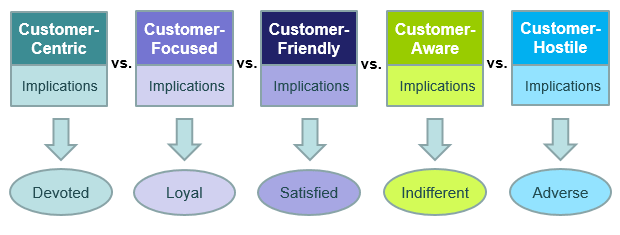
Most business leaders immediately set their sights on being Customer-Centric. This is a great aspiration but it’s important to understand what customer culture exists today and the business change required to reach your customer destination. Business success is often the result of being customer-focused (or Customer-Centric) and establishing an environment where team members are empathetic and passionate about delivering an exceptional customer experience.
One of the first steps that leaders need to take as they look to become more Customer-Centric is to discover where their business and organizations fall on the “Customer-Centricity Spectrum”. The Spectrum includes 5 categories of customer commitment, from business behaviors and attitudes considered “Customer-Hostile” to a “Customer-Centric” environment where customers are the center of daily discussions, decisions, priorities and measures.

Source: In Partnership with the Chip Bell Group
The “Centricity Spectrum” identifies customer-based attitudes and commitments within a business (i.e. Centric, Focused, Friendly, Aware and Hostile) and the customer relationships that result (i.e. Devoted, Loyal, Satisfied, Indifferent and Adverse).
As leaders look to discover where they are today, they need to have a clear understanding of the 5 spectrum categories and how their company’s day-to-day behaviors and attitudes map. For example, here is a snapshot of what a “Customer-Centric” organization might look like:
Source: In Partnership with the Chip Bell Group
Current state insight is critical to setting your desired Customer Destination (or Vision), providing awareness as to what it will take to achieve your customer goals over a specific timeframe. Customer-Centric may not be appropriate for your company today based on the amount of operational change and investment that may be required to reach this desired destination. However, there are valuable steps along the journey (moving to the left on the centricity spectrum) that you can take to help your business become more customer-focused and empathetic. Lasting customer relationships are achieved as you show a true interest in knowing your customers (their needs, wants and challenges) … and that you’re committed to their success. Where are you today on your journey to becoming a more Customer-Centric company? Do you know where you fall on the Customer-Centricity Spectrum?
We recently worked with a company where the CEO was a very people-oriented and empathetic leader. He wanted his organization to reflect his concern for people and the customer … conversations focused on being Customer-Centric. He felt this level of customer commitment would build stronger customer relationships and help to differentiate the company.
After internal analysis, the executive team discovered that their current operations fell between Customer-Aware and Customer-Friendly on the Centricity Spectrum. Based on these insights, they considered the Customer Destination they could achieve over the course of a 3 year period. They found that setting their sights on “Centric” would prove to be too large of a leap from where they stood at the time (specifically, the operational change in behaviors and decision making and the associated cost). As a result, they set their sights on becoming Customer-Focused with the objective to continue to change the culture and over-time revisit the possibility of becoming Customer-Centric.
Being Customer-Focused was a big step forward for the company. Employees were enthusiastic and excited to be involved in customer experience activities that had them working together on setting their Customer Destination. They not only created “What” but “How”, establishing standards and norms (i.e. new behaviors and attitudes) aligned with being Customer-Focused. They set new customer-oriented goals and launched new initiatives to help change the culture and improve their focus on customer … employee morale improved, customer satisfaction increased and more customers were becoming advocates.